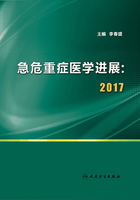
第三章 体外膜肺与急诊(二)
近年来,随着医疗技术的不断进步,心脏骤停患者的心肺复苏(CPR)成功率也在不断提高,自主循环恢复(ROSC)率可达40%~60%,但出院生存率仍较低,在美国登记注册的院内心脏骤停(IHCA)患者的出院生存率为22.3%[1],院外心脏骤停(OHCA)患者仅为9%[2]。有资料显示,当心脏骤停时,即使可进行高质量的CPR,产生的心排量也仅为正常的25%~30%,颈动脉平均压很少能超过5.3kPa,心肌血量仅为正常的20%,同时随着CPR的进行,心肌缺血的时间逐渐延长,使其反应性下降,最终失去对各种治疗措施的反应性,从而导致CPR失败[3],另外CPR前的全身性缺血缺氧,以及复苏后全身缺血-再灌注损伤,进一步导致包括心脏骤停后脑损伤、心肌功能不全,甚至出现全身性炎症反应综合征等复杂的病理生理学过程,引起所谓的“复苏后多器官功能障碍综合征”,直接影响CPR患者的预后及生存率[4]。因此,寻求一种高效、安全、有效的CPR治疗方法对提高生存率至关重要。
体外膜肺氧合(extracorporeal membrane oxygenation,ECMO)是在体外循环装置基础上发展而来的一种新型呼吸循环支持技术,其工作原理是将静脉血引出体外,在血泵驱动下,经过膜式氧合器氧合,再将血液回输到病患体内。离心泵产生循环动力,替代了心脏功能,血液的转流减轻了心脏负荷、增加了脏器的灌注,膜式氧合器替代了肺的功能,提高了血液的氧合,提供全身氧供,使用ECMO后即使病患没有自主循环与呼吸,主动脉和冠脉中的血液经过氧合后,机体的氧分压与血氧饱和度仍能维持基本的生物学生命,使心肺得到充分休息,为治疗原发病赢得时间。动物研究模型已经证实[5,6]ECMO在心肺复苏应用方面可行、有效,可增加ROSC恢复率,显著提高CPR的存活率,但临床方面的研究较少,且多为单中心回顾性研究,因此,本人对ECMO的研究进展及在CPR的临床应用方面做一综述。
一、ECMO类型
ECMO是采用体外循环设备进行循环、呼吸支持的一种辅助技术,能够快速改善呼吸衰竭患者的低氧血症及失代偿期的心功能不全。根据管路回流形式,ECMO主要分为VV(venovenous)-ECMO和VA(venoarteria)-ECMO(图1-2-1)。VV-ECMO 可部分或全部替代肺功能,主要用于成人急性肺损伤、急性呼吸窘迫综合征、急性呼吸衰竭及肺移植手术的患者,而VA-ECMO主要用于循环衰竭、心脏骤停及心外科术后的辅助支持,也可用于呼吸衰竭患者。
二、ECMO的作用机制
(一)增加冠脉血流
提高主动脉的压力和恢复冠状动脉血流是CPR复苏成功的基础,国内外研究已证明[6-8]CPR联合ECMO在提高主动脉压力和冠脉血流方面均优于单一CPR,ECMO建立后,即使自主循环与自主呼吸未恢复,但主动脉与冠脉内的血流仍为氧合的动脉血,PaO2和SaO2仍可达到基本的生理要求,同时可降低心脏前后负荷,有助于自主心跳恢复,增加组织器官灌注。
(二)保护脑细胞
有效自主循环的建立以及脑复苏成功是挽救生命的前提,心脏骤停期间的体温变化及低氧血症引起脑血管收缩、氧离曲线左移以及脑血流灌注异常,导致脑组织缺血缺氧,糖代谢紊乱,引起脑氧耗/脑糖耗(CMRO2/CMRGlu)比值下降,与复苏后神经功能障碍密切相关[7],国内有研究显示[8]CPR后脑氧供相对增加,无氧糖酵解减少,使CMRO2/CMRGlu升高,而ECMO组CMRO2/CMRGlu比值升高明显高于常规CPR组,提示ECMO更能有效改善脑氧代谢及能量代谢,减轻脑损伤,同时ECMO还可酌情进行亚低温治疗,减少组织器官的缺血-再灌注损伤,有助于器官功能恢复。
三、ECMO在CPR的临床应用
(一)ECMO治疗前的病人选择
尽管多项观察性研究显示,对非心外科术后院外或院内心脏骤停,ECMO复苏成功率显著优于传统的CPR[9-13],但对于应用ECMO的病人选择仍需慎重,以期获得最大风险效益比,因此,美国心脏病协会(AHA)指南推荐,对于循环时间较短、病因可逆或符合心脏移植指征的患者,可考虑应用ECMO治疗(Ⅱb,C类证据)[14],具体的入选及排除标准详见表1-3-1[15]。

(二)ECMO的应用时机
复苏后应用ECMO的最佳时间目前尚无统一意见。国内丘俊涛等[16]研究认为经CPR15分钟未恢复稳定的自主循环,排除严重的脏器损伤及明确的不可逆转的病因,即有进行ECMO的指征。研究表明,CPR时间长短与ECMO抢救的成功率密切相关,随着CPR时间的延长,患者病死率及神经系统的并发症风险显著增加,CPR超过30分钟,生存率下降5%[17],但亦有CPR时间超过176分钟,仍有良好的神经系统预后的报道[18]。目前,大多数研究比较认同CPR时间超过10分钟仍无法建立ROSC作为应用ECMO的时机[19-21]。
(三)应用ECMO后的预后因素
复苏后应用ECMO后多种指标可预测患者的预后。有研究发现ECMO前的乳酸水平及乳酸恢复正常的时间与预后密切相关[16,22],乳酸为反映全身微循环灌注的重要指标,乳酸水平的下降表明脏器微循环灌注好转,心功能改善,江春景等[21]使用多因素Logistics回归分析发现应用ECMO后12h乳酸值为影响预后的独立危险因素,国外研究也获得了同样的结果,认为使用ECMO后最初24小时内的乳酸峰值可预测30d病死率[23],另国内黄雷[24]等在ECMO联合急诊PCI在急性心梗后心脏骤停的研究中发现,与存活组相比,死亡组的ECMO辅助后48h平均动脉压更低,动脉乳酸水平较高,提示应用ECMO后48h的平均动脉压及乳酸水平是反映预后的重要指标。国外亦有文献报道复苏后平均动脉压>60mmHg[25]、年龄≤66岁、可电复律节律、低灌注时间≤38分钟、脉压差>24mmHg、SOFA评分≤14分[26]、复苏后的乳酸清除率[27]、入院时的瞳孔直径[28]是存活出院或改善神经系统结局的独立预测因素。此外,应用ECMO前的急性生理评分、低体温[29]、血肌酐峰值[16]、最初24小时内少尿[30]、低肾小球滤过率[31]、低血红蛋白血症、心脏骤停至应用ECMO间隔时间较长[32]均可独立预测病死率或神经系统的不良结局,而短时间的应用低流量ECMO、动脉血高pH值、入院时的低乳酸水平[33]、休克型心脏节律[33,34]和INR≤2.4[34]提示着具有较高的出院存活率。
(四)ECMO的撤机指征
在应用ECMO过程中维持平均动脉压(MAP)>60mmHg即可,应用ECMO后患者血流动力学稳定、心脏超声示左室射血时间>200ms、无酸碱失衡及电解质紊乱、无致命性心律失常、左室射血分数(LVEF)>40%、辅助流量能减少至正常心排量的10%~20%可考虑撤机[35]。
(五)ECMO治疗的并发症
ECMO是一种有创的心肺辅助手段,辅助期间可能出现各种并发症,直接影响患者预后。Cheng等[36]一项包括12个研究1866例在心源性休克及心脏骤停患者中应用ECMO的荟萃分析显示累积存活率为20.8%~65.4%,研究发现的并发症为下肢缺血、筋膜切开术或筋膜室综合征、下肢截肢、中风、中枢神经系统并发症、急性肾损伤、需肾脏替代治疗、大出血、出血再开胸、心脏术后心脏压塞及重症感染等,其中主要并发症为急性肾损伤(35.5%~74.0%)、需肾脏替代治疗(36.7%~55.5%);其次为大出血(26.8%~56.6%)及重症感染,大出血尤以颅内出血最为严重,可能与长期应用肝素、血小板减少、凝血因子消耗有关,长时间置管应用ECMO、机械通气及院内感染是重症感染的主要原因[15]。另外,空气栓塞、血小板减少、获得性血管性血友病综合征、DIC、溶血也是应用ECMO过程中的少见并发症[15]。
四、前景与展望
虽然国内外研究已经证实ECMO在抢救心脏骤停患者其存活率及神经系统结局均优于传统的CPR,但建立优秀的ECMO团队缩短置管时间、严格掌握适应证、缩短CPR时间、减少并发症仍是ECMO成功的关键,将来随着ECMO技术的日趋成熟,ECMO将会更多应用于危重症医学,特别在CPR方面的心肺保护作用使这一技术有着广阔的应用前景,有望成为CPR治疗的新方法与发展方向。
(刘波 曾红)
参考文献
1.Girotra S,Nallamothu BK,Spertus JA,et al.Trends in survival after in-hospital cardiac arrest.N Engl J Med,2012,15.367(20):1912-1920.
2.Abrams HC,McNally B,Ong M,et al.A composite model of survival from out-of-hospital cardiac arrest using the Cardiac Arrest Registry to Enhance Survival(CARES).Resuscitation,2013,84(8):1093-1098.
3.Morimura N,Sakamoto T,Nagao K,et al.Extracorporeal cardiopulmonary resuscitation for out-of-hospital cardiac arrest:A review of the Japanese literature.Resuscitation,2011,82(1):10-14.
4.Nolan JP,Neumar RW,Adrie C,et al.Post-cardiac arrest syndrome:epidemiology,pathophysiology,treatment,and prognostication.A Scientific Statement from the International Liaison Committee on Resuscitation;the American Heart Association Emergency Cardiovascular Care Committee;the Council on Cardiovascular Surgery and Anesthesia;the Council on Cardiopulmonary,Perioperative,and Critical Care;the Council on Clinical Cardiology;the Council on Stroke.Resuscitation,2008,79(3):350-379.
5.Pretto E,Safar P,Saito R,et al.Cardiopulmonary bypass after prolonged cardiac arrest in dogs.Ann Emerg Med,1987,16(6):611-619.
6.Stub D,Byrne M,Pellegrino V,et al.Extracorporeal membrane oxygenation to support cardiopulmonary resuscitation in a sheep model of refractory ischemic cardiac arrest.Heart Lung Circ,2013,22(6):421-427.
7.Massimo M,Marine T,Olivier LP,et al.Back from irreversibility:extracorporeal life support for prolonged cardiac arrest.Ann ThoracSurg,2005,79:178-184.
8.蒋崇慧,黄子通,谢钢,等.经股动-静脉体外膜肺氧合在心肺复苏中的实验研究.南方医科大学学报,2008,4:521-523.
9.Kagawa E,Inoue I,Kawagoe T,et al.Assessment of outcomes and differences between in-and out-of-hospital cardiac arrest patients treated with cardiopulmonary resuscitation using extracorporeal life support.Resuscitation,2010,81(8):968-973.
10.Chen YS,Lin JW,Yu HY,et al.Cardiopulmonary resuscitation with assisted extracorporeal life-support versus conventional cardiopulmonary resuscitation in adults with in-hospital cardiac arrest:an observational study and propensity analysis.Lancet,2008,372(9638):554-561.
11.Lin JW,Wang MJ,Yu HY,et al.Comparing the survival between extracorporeal rescue and conventional resuscitation in adult in-hospital cardiac arrests:propensity analysis of three-year data.Resuscitation,2010,81(7):796-803.
12.Shin TG,Choi JH,Jo IJ,et al.Extracorporeal cardiopulmonary resuscitation in patients with inhospital cardiac arrest:A comparison with conventional cardiopulmonary resuscitation.Crit Care Med,2011,39(1):1-7.
13.Fagnoul D,Taccone FS,Belhaj A,et al.Extracorporeal life support associated with hypothermia and normoxemia in refractory cardiac arrest.Resuscitation,2013,84(11):1519-1524.
14.Cave DM,Gazmuri RJ,Otto CW,et al.Part 7:CPR techniques and devices:2010 American Heart Association Guidelines for Cardiopulmonary Resuscitation and Emergency Cardiovascular Care.Circulation,2010,122(18 Suppl 3):S720-728.
15.Patel JK,Schoenfeld E,ParniaS,et al.Venoarterial Extracorporeal Membrane Oxygenation in Adults With Cardiac Arrest.J Intensive Care Med,2016,31(6):359-368.
16.丘俊涛,罗新锦,王巍,等.ECMO技术在成人体外心肺复苏中的效果分析.中华胸心血管外科杂志,2016,32(5):265-268.
17.deMos N,van Litsenburg RR,et al.Pediatric in-intensive-care-unit cardiac arrest:incidence,survival,and predictive factors.Crit Care Med,2006,34(4):1209-1215.
18.Kelly RB,Porter PA,Meier AH,et al.Duration of cardiopulmonary resuscitation before extracorporeal rescue:how long is not long enough?ASAIO J,2005,51(5):665-667.
19.Goldberger ZD,Chan PS,Berg RA,et al.Duration of resuscitation efforts and survival after in-hospital cardiac arrest:an observational study.Lancet,2012,380(9852):1473-1481.
20.Reynolds JC,Frisch A,Rittenberger JC,et al.Duration of resuscitation efforts and functional outcome after outof-hospital cardiac arrest:when should we change to novel therapies?Circulation,2013,128(23):2488-2494.
21.江春景,杨峰,郝星,等.体外膜肺氧合辅助院内难治性心脏骤停患者转归的预测指标.心肺血管病杂志,2015,34(12):899-903.
22.Sherwin ED,Gauvreau K,Scheurer MA,et al.Extracorporeal membrane oxygenation after stage 1 palliation for hypoplastic left heart syndrome.J ThoracCardiovascSurg,2012,144(6):1337-1343.
23.Rigamonti F,Montecucco F,Boroli F,et al.The peak of blood lactate during the first 24h predicts mortality in acute coronary syndrome patients under extracorporeal membrane oxygenation.Int J Cardiol,2016,221:741-745.
24.黄雷,刘迎午,李彤,等.体外膜肺氧合联合急诊经皮冠状动脉介入治疗抢救急性心肌梗死后心脏骤停的效果.中华心血管病杂志,2016,44(7):570-576.
25.Shin TG,Jo IJ,Sim MS,et al.Two-year survival and neurological outcome of in-hospital cardiac arrest patients rescued by extracorporeal cardiopulmonary resuscitation.Int J Cardiol,2013,168(4):3424-3430.
26.Park SB,Yang JH,Park TK,et al.Developing a risk prediction model for survival to discharge in cardiac arrest patients who undergo extracorporeal membrane oxygenation.Int J Cardiol,2014,177(3):1031-1035.
27.Bednarczyk JM,White CW,Ducas RA,et al.Resuscitative extracorporeal membrane oxygenation for in hospital cardiac arrest:a Canadian observational experience.Resuscitation,2014,85(12):1713-1719.
28.Maekawa K,Tanno K,Hase M,et al.Extracorporeal cardiopulmonary resuscitation for patients with out-of-hospital cardiac arrest of cardiac origin:a propensity-matched study and predictor analysis.Crit Care Med,2013,41(5):1186-1196.
29.Anselmi A,Flécher E,Corbineau H,et al.Survival and quality of life after extracorporeal life support for refractory cardiac arrest:A case series.J ThoracCardiovascSurg,2015,150(4):947-954.
30.Lee JJ,Han SJ,Kim HS,et al.Out-of-hospital cardiac arrest patients treated with cardiopulmonary resuscitation using extracorporeal membrane oxygenation:focus on survival rate and neurologic outcome.Scand J Trauma ResuscEmerg Med,2016,24:74.
31.Kuroki N,Abe D,Iwama T,et al.Prognostic effect of estimated glomerular filtration rate in patients with cardiogenic shock or cardiac arrest undergoing percutaneous veno-arterial extracorporeal membrane oxygenation.J Cardiol,2016,68(5):439-446.
32.Ryu JA,Cho YH,Sung K,et al.Predictors of neurological outcomes after successful extracorporeal cardiopulmonary resuscitation.BMC Anesthesiol,2015,15:26.
33.Debaty G,Babaz V,Durand M,et al.Prognostic factors for extracorporeal cardiopulmonary resuscitation recipients following out-of-hospital refractory cardiac arrest.A systematic review and meta-analysis.Resuscitation,2017,112:1-10.
34.deChambrun MP,Bréchot N,Lebreton G,et al.Venoarterial extracorporeal membrane oxygenation for refractory cardiogenic shock post-cardiac arrest.Intensive Care Med,2016,42(12):1999-2007.
35.于洁,乔叶薷,马金辉,等.基于德尔菲法构建体外膜肺氧合辅助心肺复苏临床治疗专家共识.中国体外循环杂志,2016,14(4):193-196.
36.Cheng R,Hachamovitch R,Kittleson M,et al.Complications of extracorporeal membrane oxygenation for treatment of cardiogenic shock and cardiac arrest:a meta-analysis of 1,866 adult patients.Ann ThoracSurg,2014,97(2):610-616.